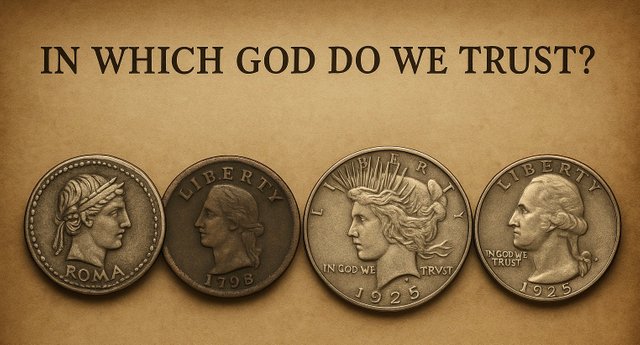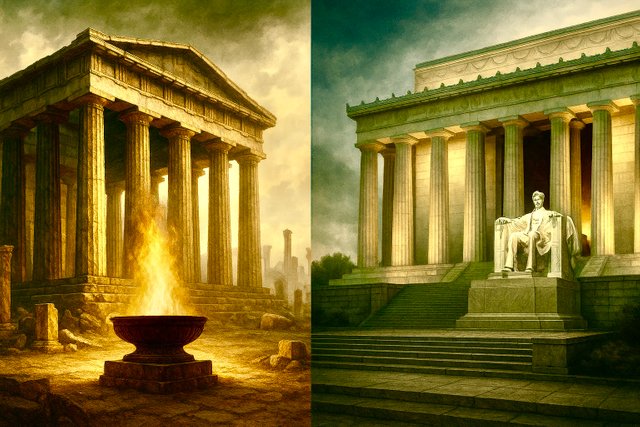This day in History April 22, 1864 — The Day the Divine Was Minted
This Day in History: In Which God Do We Trust?
April 22, 1864 —
The United States Congress approved the use of the phrase
“In God We Trust” on U.S. coins for the first time.
It seemed like a humble confession.
“A nation, torn by civil war, sought to remind itself that God still reigned.”
Really? Or was there something much more devious going on? Something exposing the Prophetic truth to come?
But which God?

Not the God of Abraham, Isaac, and Jacob.
Not the Father of our Lord Jesus Christ.
Not the One who said, “Ye must be born again.”
April 22, 1864 — The Day the Divine Was Minted
Today marks the day when, for the first time in U.S. history, the phrase “In God We Trust” was authorized to appear on American coins.
It was 1864. The Civil War was tearing the nation apart. In desperation, Congress and the Treasury turned to a divine phrase —
not to turn hearts toward Christ, but to try and bind a fractured people with three words.
But the question echoes louder now than ever:
In which God do we trust?
Not the God of Abraham, Isaac, and Jacob.
Not the Lamb slain from the foundation of the world.
Not the risen Christ who offers salvation to repentant sinners.
Instead, a new god began to be etched into the fabric of the republic —
a god of ritual, symbol, and slogan.
⸻
A Nation Baptized in Ceremony
In 1942, the U.S. Congress enacted the Flag Code,
declaring that the American flag “represents a living country and is itself considered a living thing.”
From that moment forward, the flag was no longer just a symbol — it was a sacred object,
to be saluted, never defiled, and ritually cremated by fire when no longer fit for service.
This was no empty law.

It mirrored the practices of pagan Rome,
where Caesars were cremated on pyres, deified by fire, their ashes lifted to the heavens.
It mirrored Theosophy, where mystics like Helena Blavatsky promoted cremation as spiritual release —
and where men like Freemason Henry A. Wallace, vice president under 32nd degree Freemason FDR and admirer of mystic Nicholas Roerich,
ushered that same spirit into the government through ritual, design, and currency.
⸻
The Land Called Rome
But the roots go even deeper.
The very land upon which Washington, D.C. now stands was once a tract of farmland owned by a man named Francis Pope.
And in a twist of historical irony, he named his land “Rome,”
and the stream running through it, “Tiber Creek.”
Quite a coincidence — a man named Pope, owning a farm called Rome,
by a river named Tiber — on the very ground where the Capitol would one day rise.
Today we call it a city on a hill —
but its streets form Masonic patterns, its monuments mimic pagan temples,
and its spiritual architecture was drawn not from Zion, but from the ruins of empire.
⸻ Symbolic City Planning
The design of Washington, D.C., was heavily influenced by Pierre Charles L’Enfant, a French architect and Freemason. The city’s layout includes numerous elements reminiscent of Roman architecture and symbolism:
• Capitol Hill: Named after Rome’s Capitoline Hill, it’s the seat of the U.S. Congress.
• The Capitol Dome: Inspired by St. Peter’s Basilica in Vatican City.
• The Washington Monument: An obelisk reminiscent of ancient Egyptian and Roman monuments.
• Street Layout: The city’s streets form patterns, including a pentagram, which some interpret as containing esoteric symbolism.
These design choices reflect a deliberate attempt to associate the new American republic with the grandeur and authority of ancient Rome.
A Flag Cremated, a Republic Deified
The nation began to treat cloth as life,
metal as covenant,
pledges as prayers,
and buildings as sanctuaries.
But God does not dwell in temples made with hands.
He does not accept the bloodless loyalty of those who deny His Son.
“This people honoureth me with their lips, but their heart is far from me.”
— Mark 7:6
⸻
Christ Still Asks:
“Whom say ye that I am?”
— Matthew 16:15

Coins say “God.”
The flag is called alive.
The pledge demands allegiance.
But Christ asks for the heart.
And still, the world prepares for one who will come in his own name —
and him, they will receive.
⸻
Final Warning:
The symbols are no longer just art.
They are conditioning — preparing the world to receive the Beast,
and to once again worship Rome.
“Come out of her, my people, that ye be not partakers of her sins.”
— Revelation 18:4
⸻
Friend, the road paved with gold and flags leads not to life, but to death.
The idols of nations will fall.
The symbols of man’s pride will burn.
The kingdoms of this world will become the kingdoms of our Lord and of His Christ —
but only those whose names are written in the Lamb’s Book of Life shall enter in.
Today, Christ is still calling.
Not to loyalty oaths.
Not to ceremonies or slogans.
But to repentance.
To faith.
To life eternal.
“That if thou shalt confess with thy mouth the Lord Jesus, and shalt believe in thine heart that God hath raised him from the dead, thou shalt be saved.”
— Romans 10:9 (KJV)
Will you trust in a nation that will fall?
Or in a King who lives forever?
Today — if ye will hear His voice —
turn to Christ.
“Believe on the Lord Jesus Christ, and thou shalt be saved.”
— Acts 16:31 (KJV)
This Day in History
The world forgets. Christ still calls.